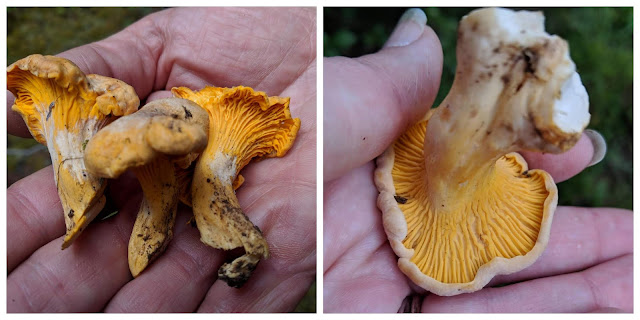Monday, August 20, 2018
Telluride Mushroom Festival pt1: Fungal foray finds!
For the past 5 days, my husband and I have been at the Telluride Mushroom Festival! It's been an incredible trip, with lectures about mycoremediation (using fungi to clean up the environment and break down trash and contaminates), mushroom hunting forays, a parade, community and more.
I've been trying to get the time to write some huge posts, but there is just way too much I've learned, and the posts were out of control long. Instead I've decided to do some micro-posts on specific topics.
I'm working off my phone, so I apologize for typos and incomplete photo records. I'll clean up these posts when I get home.
So for this first micro-post, I'd like to provide an overview of the fungi our mushroom-hunting teams found at our all-day forays on Thursday and Friday.
The conditions in Colorado have been unusually dry, which unfortunately led to mushrooms being fairly scarce. But while we missed out on quantity, it forced us to really look hard and be super observant. The result is that a good deal of variety was found!
If I go alphabetically by Latin name, this cross-hatched mushroom comes first. It's Albatrellus ovinus, a common mushroom in the Colorado Mountains. Because it doesn't grow in the Northeast or Texas, it was a new shroom for me. I'll publish a micro-post about my experience with finding this tommorow.
My husband actually found the only King Bolete of the week. This large, but slightly eaten Boletus was formerly known as Boletus Edulis, but is now called B. rubriceps. It's still a close relative of the true Porcini. I'll do a micro-post on this mushroom in the coming week.
Chanterelles, aka Cantharellus cibarius, are choice edible mushrooms, fairly easy to ID. Apparently many years these are found in great abundance, and somewhat larger size. With the dry conditions these were fairly small and hard to find, but still everyone in our group got at least one, and my husband found many.
I'll be putting together a full identification post for chanterelles soon!
Cortinarius species, like these, were out in abundance. "Corts" are potentially dangerous mushrooms, and while none in the Colorado Rockies have yet to cause serious harm, in other places these fungi have caused organ failures and deaths. I'll work up a micro-post on Cortinarius soon!
These are deadly Galerina mushrooms, Galerina marginata. I was told that they are the only known-to-be-deadly mushrooms that grow in the Telluride mountains, but they resemble several edible species. I'll do a micro-post on them soon!
Above is Russula Xerampelina, better known as the "shrimp" Russula, because it supposedly smells and tastes like seafood. This mushroom is extremely frustrating for me, I'll go into why in a micro-post next week.
These are Sarcodon imbricatus, a common toothed fungus that doesn't grow anywhere I've lived, so this is the first time I'm encountering it. Common names include: hawk's wing, scaly tooth and scaled hedgehog. I'll do a mini-post in the coming week.
Subscribe to:
Post Comments (Atom)









No comments:
Post a Comment